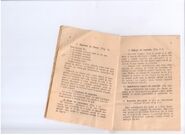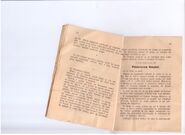The Romanian Md.35 was a civil defence respirator available during the pre-war period. It is very similar to the Polish Wz. 32 mask, because it was produced in Romania under a Polish license. A common misconception that these were military masks, but in fact these were mainly for the civilians, only rarely were used by the army because the Md.32 was the main military mask.
Mask overview[]
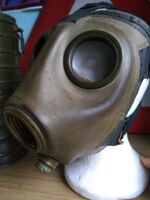
The Md.35 mask is identical to the normal Romanian made Md.32 mask. The faceblank is made of a drab brown rubber, this is often a source of confusion for collectors because it is more or less identical to the later variants of the Polish Wz.32 (early Wz.32 models use a grey/green fabric on the exterior, making it easy to identify what mask is what).
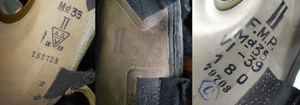
ANTIGAZ, SAROGAZ and F.M.P. manufacturer stamps. Size (II), serial numbers (79703) and manufaturing date (VI-39)
One of the easiest ways to tell Polish and Romanian masks apart is to look at the stamping that should feature on the mask's side, the Romanian masks feature Roman size numbers (I, II, III). The Md.35 was made by three main Romanian companies - "ANTIGAZ" S. A. R. Fabrica Vulcan, "SAROGAZ" S. A. R. Fabrica Bucuresti and Fabrica Materiale de Protrctie (F.M.P.). Note that despite the common misinformation F.M.P. was a Romanian company, not Polish.
The Md.35s eyepieces were of typical construction. Glass lenses were affixed to the mask with crimped metal. Internally, a tan fabric surrounds the periphery of the eyepiece assembly, extending about 3,5cm out. This appears to be a strengthening solution - adding overall rigidity. Some form of rubber gasket was also most likely added - to ensure the eyepiece assembly forms a gas-tight seal.
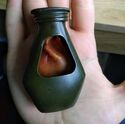
Closeup of valve housing with the triangular hole
Underneath the intake valve assembly, is a small threaded metal protrusion which holds the exhale flapper valve and its metal housing. The metal housing itself threads into the Md.35 masks protrusion and protects the fragile flapper valve from damage. The bottom of the valve protector sports 3 holes - 2 capsule-shaped holes on left and right sides and a circular hole on the very bottom. This ensures exhaled air is expelled from the mask smoothly. Further up the house assembly are two more triangular-like holes. Note that in the photo to the left, the flapper valve is inside the guard housing. This is technically not correct - the flapper valve should remain on the mask. The guard housing was designed to simply thread over the flapper valve, not actually contain it. This happened because on this example, the rubber on the flapper valve had dried up and rotted away.
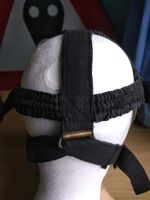
Closeup of harness system
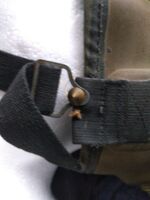
Md.35 harness clip
Md.35 masks utilise a 5-point (two straps on each temple are connected to the faceblank trough one single strap, otherwise it would be 7-point) head-harness made of elasticated black fabric straps which are adjustable via metal buckles. Each portion of the mask that has a strap attached to it, has a raised plane of rubber because the straps weren't just sewn but vulcanised to the faceblank as well. To this raised rubber area, the strap is stitched on in a 'X' fashion with a final line of parallel stitching on either side of the 'X' stitching. To add to this, a layer of fabric glue was added. The bottom strap on the left-hand side sports a 'D' ring that clips into a metal stud on the other side.
Interior[]
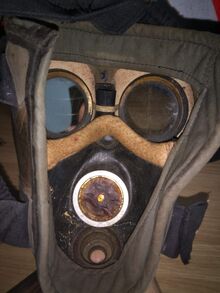
Inside view
This mask was very well constructed in comparison to other civilian masks from this era. Most noticeably, the Md.35 borrows the early peripheral seal design from the Polish Wz.32 and German types, it is constructed in an identical fashion. During the mask's construction, a grey/green fabric was stretched over the edging of the mask's interior and the fabrics overhang was subsequently folded onto the outside of the masks edging. To secure this fabric into place internally, two parallel rows of stitching were used. The external overhang was fixed into place with some kind of glue adhesive.
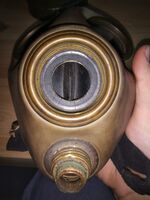
Closeup of intake assembly
The Md.35 has a 42 mm intake assembly is made of threaded metal that the rubber has been pinched around. A black rubber gasket ensures a good seal when the filter is threaded on. A small rubber ramp-like protrusion from the intake assembly splits incoming air into two left and right streams. The airflow is then directed to the eyepieces, defogging them. Then the air enters the pipe between the eyepieces, this pipe leads to the intake disc valve located in the oral-nasal cup. The air-pipe is secured in place by a small strap made from fabric and is stitched into place. The oral-nasal cup is fashioned from a tan fabric, which was stitched to the fabric used to form the peripheral seal. Inside, the cup is made from black rubber. A nose bridge made from a soft fabric was stitched to the top edging of the oral-nasal cup to ensure a comfortable fit. This nose bridge was stitched directly onto the black rubber of the oral-nasal cup.
Filter[]
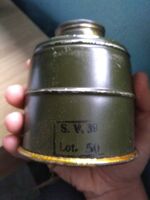
Closeup of filter
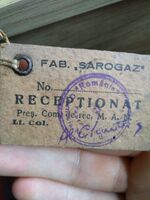
Closeup of filter tag
The filter was a small canister usually with a lot number on them. It would appear that SAROGAZ and F.M.P. filters were painted green and filters used by Md.35s made by ANTIGAZ were painted red. It is unknown if the composition of these filters is any different.
SAROGAZ filters came with a tag attached to the filter via a piece of twine that itself was attached to the filters rubber plug.
Carrying canister[]
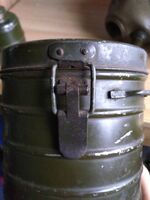
Latch on canister
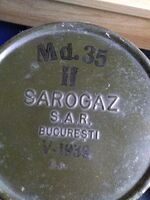
Tin lid for SAROGAZ example
The Md.35 was issued in a tall metal canister, similar to many German models. It was painted green and sported a metal latch for opening and closing. The lid of the canister was stamped with the manufacturers' name and the words 'Md.35' on them. While the bottom of the canister features a CONCORDIA or C&Z sign, which are the manufacturer companies of the canister. The date of manufacture can also be seen on the lid - usually the month and year (e.g. V - 39 (May 1939)).
External information[]
Development[]
In mid-1935 the F.M.P. gas mask factory based on Polish licenses was ready. But the small filter wasn't available yet, this changed on the 14th of January, 1936 when Romania was given a free right to produce the so-called small absorbers for civilian masks, and onthe 27th of March, 1936, in exchange for 200,000 zlotys, it was agreed that the license would be used by the private industry in Romania. So the other two Private manufacturers, SAROGAZ and ANTIGAZ could start the production as well.
Service[]
![]() Apararea Pasiva (pre-Civil Defence
Apararea Pasiva (pre-Civil Defence![]() )
)
Civilians and civil defence workers could purchase the masks on their own for 600 lei.
![]() Armata României (Royal Romanian Army)
Armata României (Royal Romanian Army)
As mentioned before the army wasn't the main user of these masks, however it is known that some were used by the military during the war at some point.
Foreign use[]
Because of the Second Vienna Award on the 30th of August in 1940 Hungary got Northern Transylvania back from Romania.
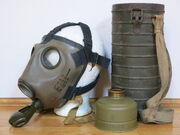
Hungarian kit.
But masks were already purchased by civilians and distributed by the Romanian government since 1938, mainly Md.35 masks because the Romanian army (Armata României) more or less left the territory before the Royal Hungarian defence forces (Magyar Királyi Honvédség) entered so Md.32 masks weren't captured.
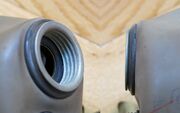
The 42 to 40 mm converter.
Just like 2 years before, in Southern Czechoslovakia after it was given back to Hungary by the First Vienna Award civilians already having masks made under the previous government could keep them after the mask was inspected, a 42 to 40 mm connector was added if needed and in this case the filter was changed to a 34M or later 41M filter.
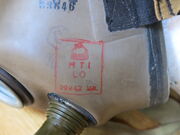
HTI stamp.
Because the mask was more advanced in some aspects than the that time current Hungarian military mask, the 34M, some examples were inspected by HTI (Haditechnikai Intézet - Institute of Military Technology) but because of its hign airflow resistance and flutter type exhale valve it was deemed outdated and unfit for service.





